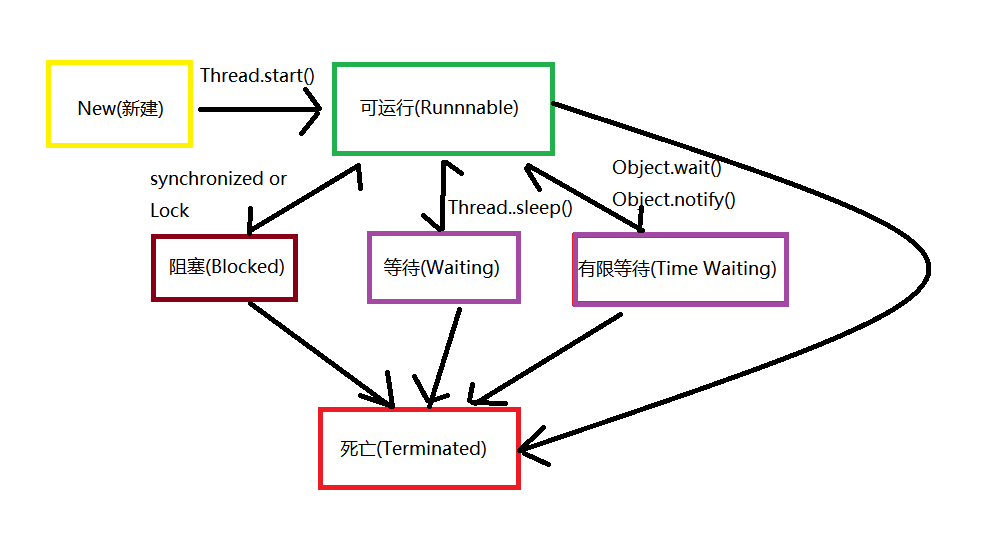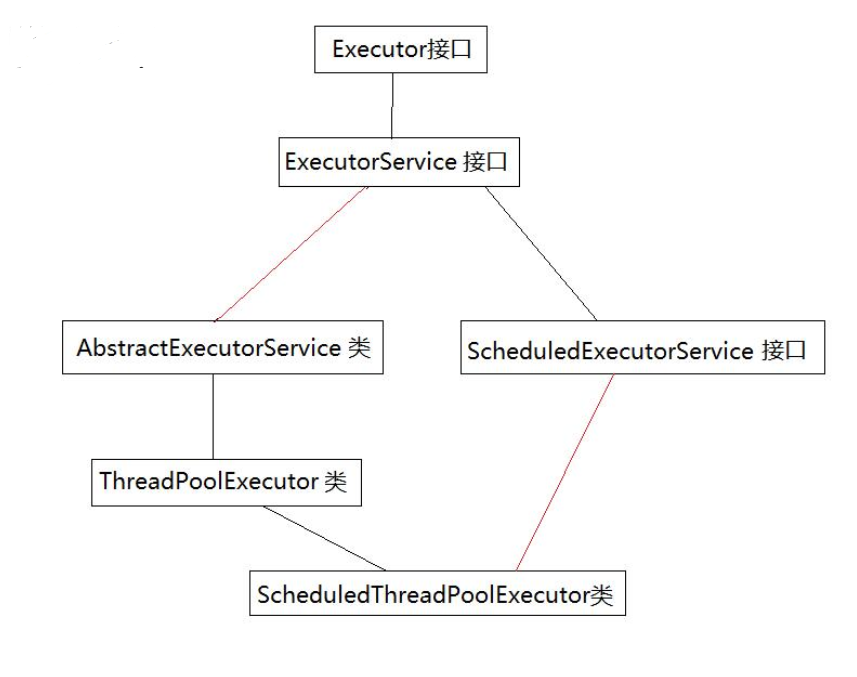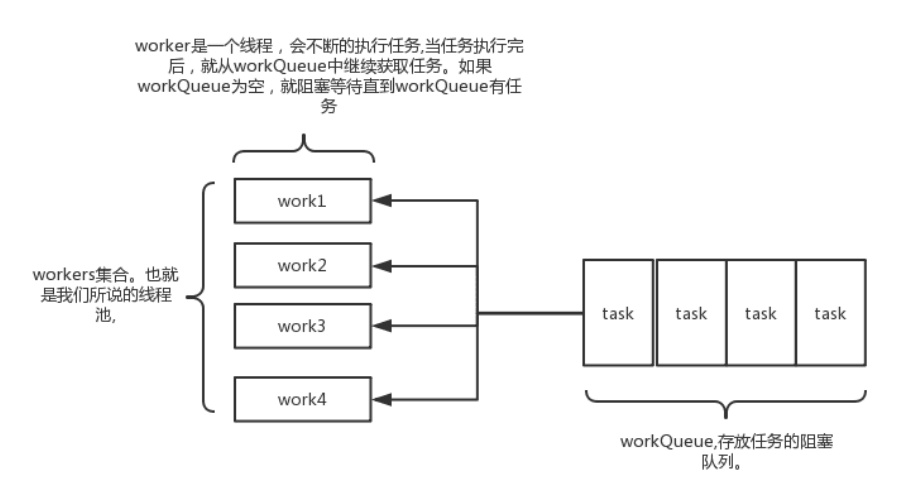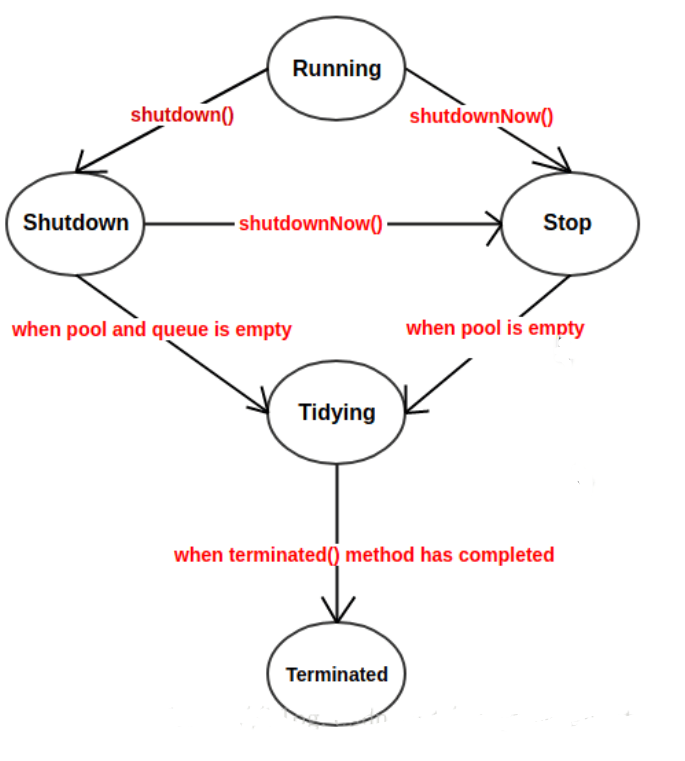Java线程
生命周期

New:线程正在创建
Runnable:线程可以运行(可能在等待时间片或正在运行)
Blocking:线程等待获取锁
Waiting:当前线程等待其他线程唤醒
Timed Waiting:当前线程等待一段时间后会自动醒来
Terminated:线程执行完毕或出现异常
线程接口
java中有三种线程的接口/类:
- Thread类
- Runnable接口
- Callable接口
使用
Thread
1
2
3
4
5
6
7
8
9
| public class MainApplication {
public static void main(String[] args) {
Thread thread = new Thread(() -> {
System.out.println("线程执行");
});
thread.start();
}
}
|
1
2
3
4
5
6
7
8
9
10
11
12
| public class MainApplication extends Thread{
public static void main(String[] args) {
MainApplication mainApplication = new MainApplication();
mainApplication.start();
}
@Override
public void run() {
System.out.println("线程执行");
}
}
|
Runnable
1
2
3
4
5
6
7
8
9
10
11
12
| public class MainApplication implements Runnable{
public static void main(String[] args) {
Thread thread = new Thread(new MainApplication());
thread.start();
}
@Override
public void run() {
System.out.println("线程执行");
}
}
|
Callable
1
2
3
4
5
6
7
8
9
10
11
12
13
14
15
| public class MainApplication implements Callable<Integer> {
public static void main(String[] args) throws ExecutionException, InterruptedException {
FutureTask<Integer> futureTask = new FutureTask<>(new MainApplication());
Thread thread = new Thread(futureTask);
thread.start();
System.out.println(futureTask.get());
}
@Override
public Integer call() throws Exception {
System.out.println("线程执行");
return 1;
}
}
|
API
静态方法
| 方法 |
说明 |
| Thread.sleep() |
休眠当前正在执行的线程 |
| Thread.yield() |
当前线程建议让出cpu,由调度器决定是否让出 |
|
|
实例方法
| 方法 |
说明 |
| thread.setDaemon() |
true为设置线程为守护线程 |
| thread.interrupt() |
中断在休眠中的线程,会抛出异常;在运行的线程则会设置标记,由线程自己决定是否中断 |
| thread.interrupted() |
获取中断标记 |
| thread.join() |
调用线程等待被调用线程执行完才会继续执行 |
| object.wait() |
挂起线程,会释放锁,只能在同步代码块里调用 |
| object.notify() |
随机唤醒线程,只能在同步代码块里调用 |
interrupt
1
2
3
4
5
6
7
8
9
10
11
12
13
14
15
16
17
18
19
20
| public class MainApplication extends Thread {
public static void main(String[] args) {
MainApplication mainApplication = new MainApplication();
mainApplication.start();
mainApplication.interrupt();
System.out.println("Main run");
}
@Override
public void run() {
try {
Thread.sleep(2000);
System.out.println("Thread run");
} catch (InterruptedException e) {
e.printStackTrace();
}
}
}
|
interrupted
1
2
3
4
5
6
7
8
9
10
11
12
13
14
15
16
17
18
19
20
21
| public class MainApplication extends Thread {
public static void main(String[] args) throws InterruptedException {
MainApplication mainApplication = new MainApplication();
mainApplication.start();
mainApplication.interrupt();
Thread.sleep(1000);
System.out.println("Main run");
}
@Override
public void run() {
while (!interrupted()) {
}
System.out.println("Thread run");
}
}
|
线程互斥/协作
互斥方式
协作方式
- join()
- wait()、notify() / notifyAll()
- await()、single() / singleAll():在Condition上使用
线程池
对线程进行统一分配,调优和监控

ThreadPoolExecutor
一个线程集合workerSet和一个阻塞队列workQueue。当用户向线程池提交一个任务(也就是线程)时,线程池会先将任务放入workQueue中。workerSet中的线程会不断的从workQueue中获取线程然后执行。当workQueue中没有任务的时候,worker就会阻塞,直到队列中有任务了就取出来继续执行。

获取线程池状态api
| 方法 |
说明 |
| threadPoolExecutor.getPoolSize() |
当前线程池中的线程数 |
| threadPoolExecutor.getCorePoolSize() |
当前线程池中核心线程的数量 |
| threadPoolExecutor.getActiveCount() |
正在执行任务的线程数 |
| threadPoolExecutor.getCompletedTaskCount() |
已经完成的任务数 |
| threadPoolExecutor.getTaskCount() |
线程池中已经提交的任务总数 |
| threadPoolExecutor.isShutdown() |
线程是否已经调用了shutdown方法 |
| threadPoolExecutor.isTerminated() |
线程是否已经执行完任务并关闭 |
创建线程池的参数
1
2
3
4
5
6
7
| public ThreadPoolExecutor(int corePoolSize, // 核心线程数
int maximumPoolSize, // 允许的最大线程数=核心+非核心
long keepAliveTime, // 非核心存活时间
TimeUnit unit, // 存活时间单位
BlockingQueue<Runnable> workQueue, // 任务阻塞队列
RejectedExecutionHandler handler // 拒绝策略
)
|
任务阻塞队列种类:
ArrayBlockingQueue: 基于数组结构的有界阻塞队列,按FIFO排序任
LinkedBlockingQueue: 基于链表结构的阻塞队列,按FIFO排序任务,吞吐量通常要高于ArrayBlockingQueue;
SynchronousQueue: 一个不存储元素的阻塞队列,每个插入操作必须等到另一个线程调用移除操作,否则插入操作一直处于阻塞状态,吞吐量通常要高于LinkedBlockingQueue;
PriorityBlockingQueue: 具有优先级的无界阻塞队列;
拒绝策略种类:
AbortPolicy: 直接抛出异常,默认策略;
CallerRunsPolicy: 用调用者所在的线程来执行任务;
DiscardOldestPolicy: 丢弃阻塞队列中靠最前的任务,并执行当前任务;
DiscardPolicy: 直接丢弃任务
线程池状态
线程池中通过原子整数ctl的前3位来记录线程池状态,后29位记录当前线程数

Executors
Executors把工作单元(Runnable)与执行机制分离开
通过Executors可以创建预设好参数的线程池,如固定大小线程池、只有救急线程的线程池等
1
2
3
4
5
6
7
8
9
10
11
12
13
14
| public class MainApplication implements Runnable {
public static void main(String[] args) {
ExecutorService pool = Executors.newCachedThreadPool();
for (int i = 0; i < 5; i++) {
pool.execute(new MainApplication());
}
pool.shutdown();
}
@Override
public void run() {
System.out.println(Thread.currentThread().getName());
}
}
|
api
| 方法 |
说明 |
| pool.shutdown() |
等所有任务执行完成后关闭线程池 |
| pool.shutdownNow() |
立即关闭线程池,所有线程执行interrupt() |
| pool.submit() |
执行有返回值的任务 |
| pool.execute() |
执行没有返回值的任务 |
为什么不建议使用Executor创建线程?
使用了无界队列,任务可以无限提交,会导致内存溢出;newCachedThreadPool如果频繁创建销毁线程会导致大量的系统开销和内存溢出
Condition
相当于等待队列
1
2
3
4
5
6
7
8
9
10
11
12
13
14
15
16
17
18
19
20
21
22
23
24
25
26
27
28
29
30
31
32
33
34
35
36
37
38
| public class MainApplication {
private Lock lock = new ReentrantLock();
private Condition condition = lock.newCondition();
public static void main(String[] args) throws InterruptedException {
MainApplication mainApplication = new MainApplication();
ExecutorService pool = Executors.newFixedThreadPool(2);
pool.execute(() -> mainApplication.before());
pool.execute(() -> mainApplication.after());
pool.shutdown();
}
public void before() {
lock.lock();
try {
condition.await();
} catch (InterruptedException e) {
e.printStackTrace();
} finally {
lock.unlock();
}
System.out.println("before");
}
public void after() {
lock.lock();
try {
condition.signal();
} finally {
lock.unlock();
}
System.out.println("after");
}
}
|



